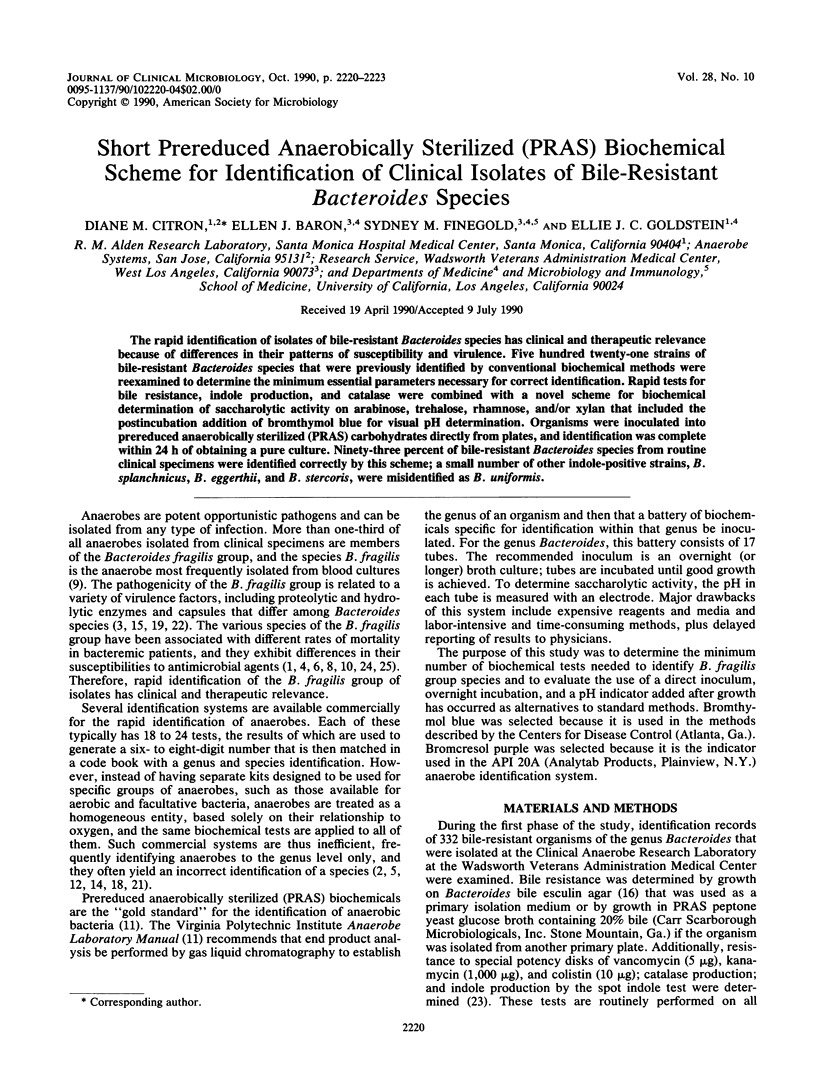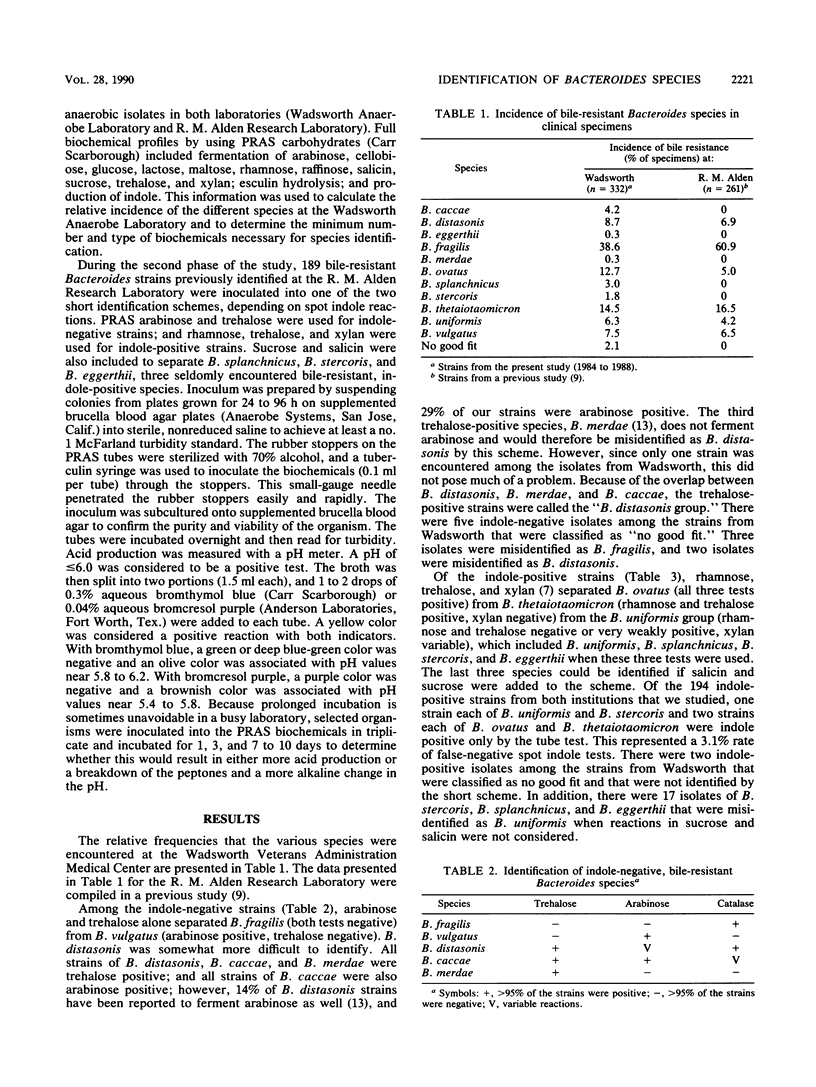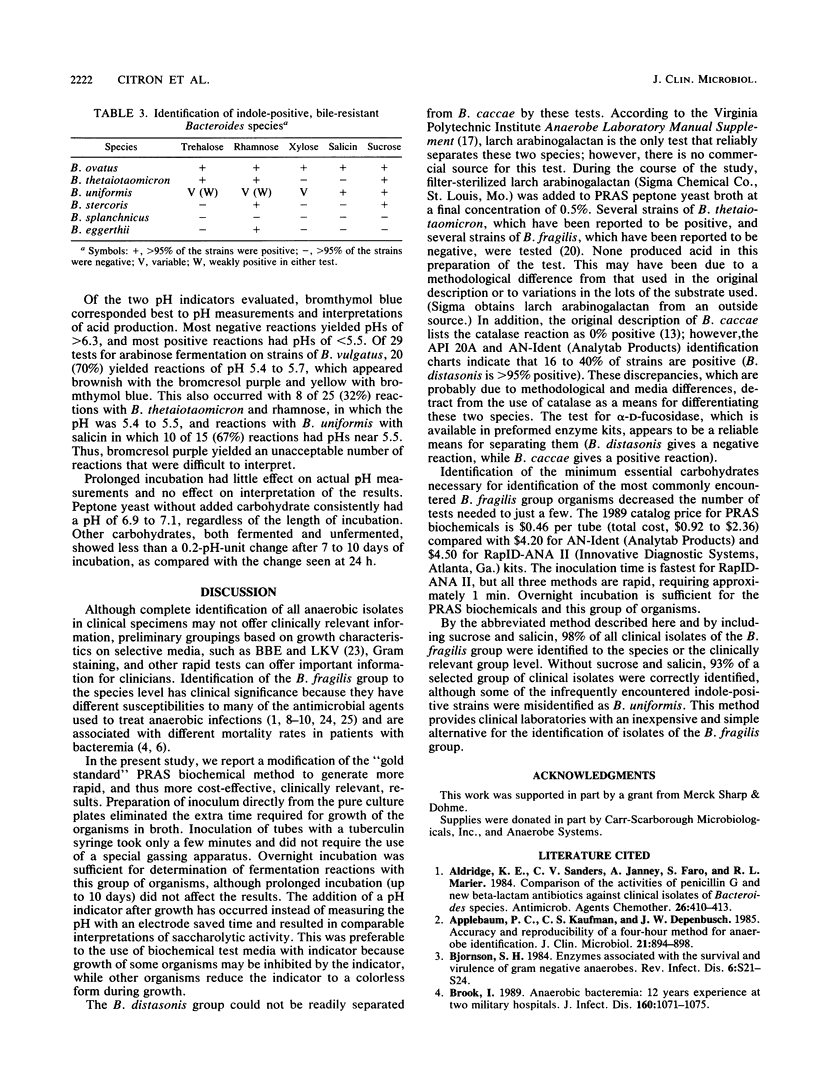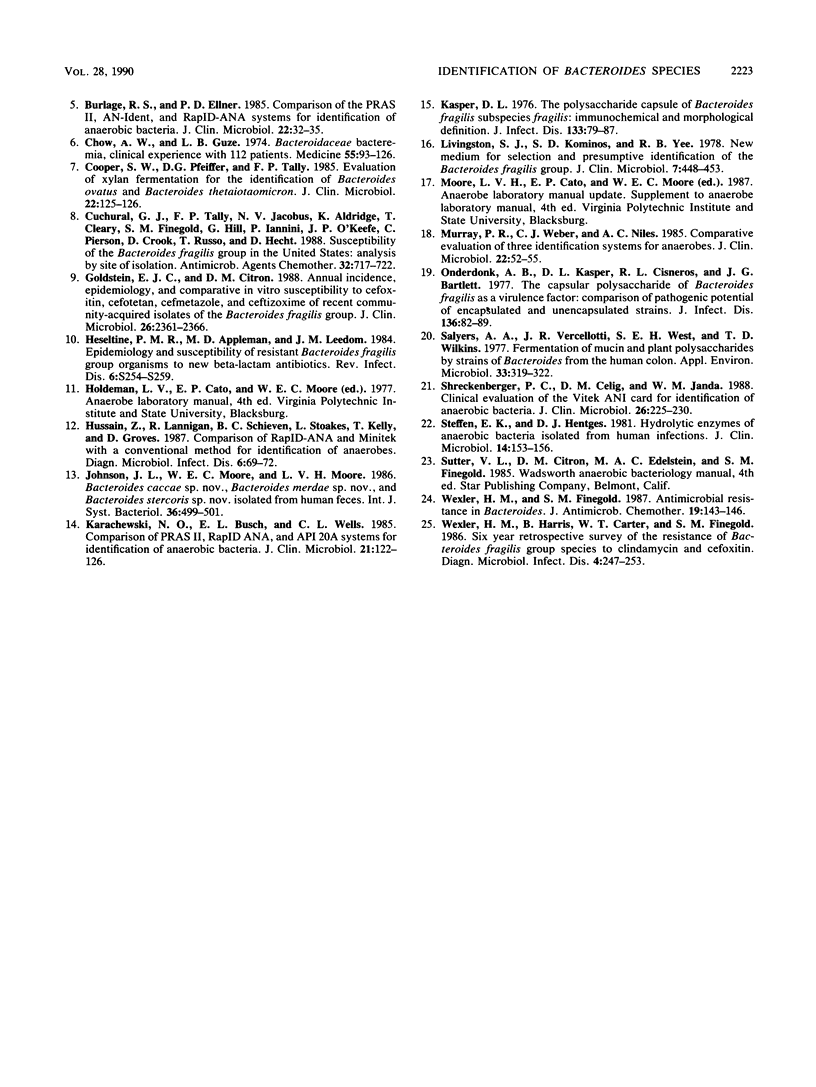Abstract
The rapid identification of isolates of bile-resistant Bacteroides species has clinical and therapeutic relevance because of differences in their patterns of susceptibility and virulence. Five hundred twenty-one strains of bile-resistant Bacteroides species that were previously identified by conventional biochemical methods were reexamined to determine the minimum essential parameters necessary for correct identification. Rapid tests for bile resistance, indole production, and catalase were combined with a novel scheme for biochemical determination of saccharolytic activity on arabinose, trehalose, rhamnose, and/or xylan that included the postincubation addition of bromthymol blue for visual pH determination. Organisms were inoculated into prereduced anaerobically sterilized (PRAS) carbohydrates directly from plates, and identification was complete within 24 h of obtaining a pure culture. Ninety-three percent of bile-resistant Bacteroides species from routine clinical specimens were identified correctly by this scheme; a small number of other indole-positive strains, B. splanchnicus, B. eggerthii, and B. stercoris, were misidentified as B. uniformis.
Full text
PDF



Selected References
These references are in PubMed. This may not be the complete list of references from this article.
- Aldridge K. E., Sanders C. V., Janney A., Faro S., Marier R. L. Comparison of the activities of penicillin G and new beta-lactam antibiotics against clinical isolates of Bacteroides species. Antimicrob Agents Chemother. 1984 Sep;26(3):410–413. doi: 10.1128/aac.26.3.410. [DOI] [PMC free article] [PubMed] [Google Scholar]
- Appelbaum P. C., Kaufmann C. S., Depenbusch J. W. Accuracy and reproducibility of a four-hour method for anaerobe identification. J Clin Microbiol. 1985 Jun;21(6):894–898. doi: 10.1128/jcm.21.6.894-898.1985. [DOI] [PMC free article] [PubMed] [Google Scholar]
- Bjornson H. S. Enzymes associated with the survival and virulence of gram-negative anaerobes. Rev Infect Dis. 1984 Mar-Apr;6 (Suppl 1):S21–S24. doi: 10.1093/clinids/6.supplement_1.s21. [DOI] [PubMed] [Google Scholar]
- Brook I. Anaerobic bacterial bacteremia: 12-year experience in two military hospitals. J Infect Dis. 1989 Dec;160(6):1071–1075. doi: 10.1093/infdis/160.6.1071. [DOI] [PubMed] [Google Scholar]
- Burlage R. S., Ellner P. D. Comparison of the PRAS II, AN-Ident, and RapID-ANA systems for identification of anaerobic bacteria. J Clin Microbiol. 1985 Jul;22(1):32–35. doi: 10.1128/jcm.22.1.32-35.1985. [DOI] [PMC free article] [PubMed] [Google Scholar]
- Chow A. W., Guze L. B. Bacteroidaceae bacteremia: clinical experience with 112 patients. Medicine (Baltimore) 1974 Mar;53(2):93–126. [PubMed] [Google Scholar]
- Cooper S. W., Pfeiffer D. G., Tally F. P. Evaluation of xylan fermentation for the identification of Bacteroides ovatus and Bacteroides thetaiotaomicron. J Clin Microbiol. 1985 Jul;22(1):125–126. doi: 10.1128/jcm.22.1.125-126.1985. [DOI] [PMC free article] [PubMed] [Google Scholar]
- Cuchural G. J., Jr, Tally F. P., Jacobus N. V., Aldridge K., Cleary T., Finegold S. M., Hill G., Iannini P., O'Keefe J. P., Pierson C. Susceptibility of the Bacteroides fragilis group in the United States: analysis by site of isolation. Antimicrob Agents Chemother. 1988 May;32(5):717–722. doi: 10.1128/aac.32.5.717. [DOI] [PMC free article] [PubMed] [Google Scholar]
- Goldstein E. J., Citron D. M. Annual incidence, epidemiology, and comparative in vitro susceptibilities to cefoxitin, cefotetan, cefmetazole, and ceftizoxime of recent community-acquired isolates of the Bacteroides fragilis group. J Clin Microbiol. 1988 Nov;26(11):2361–2366. doi: 10.1128/jcm.26.11.2361-2366.1988. [DOI] [PMC free article] [PubMed] [Google Scholar]
- Heseltine P. N., Appleman M. D., Leedom J. M. Epidemiology and susceptibility of resistant Bacteroides fragilis group organisms to new beta-lactam antibiotics. Rev Infect Dis. 1984 Mar-Apr;6 (Suppl 1):S254–S259. doi: 10.1093/clinids/6.supplement_1.s254. [DOI] [PubMed] [Google Scholar]
- Hussain Z., Lannigan R., Schieven B. C., Stoakes L., Kelly T., Groves D. Comparison of RapID-ANA and Minitek with a conventional method for biochemical identification of anaerobes. Diagn Microbiol Infect Dis. 1987 May;7(1):69–72. doi: 10.1016/0732-8893(87)90073-3. [DOI] [PubMed] [Google Scholar]
- Karachewski N. O., Busch E. L., Wells C. L. Comparison of PRAS II, RapID ANA, and API 20A systems for identification of anaerobic bacteria. J Clin Microbiol. 1985 Jan;21(1):122–126. doi: 10.1128/jcm.21.1.122-126.1985. [DOI] [PMC free article] [PubMed] [Google Scholar]
- Kasper D. L. The polysaccharide capsule of Bacteroides fragilis subspecies fragilis: immunochemical and morphologic definition. J Infect Dis. 1976 Jan;133(1):79–87. doi: 10.1093/infdis/133.1.79. [DOI] [PubMed] [Google Scholar]
- Livingston S. J., Kominos S. D., Yee R. B. New medium for selection and presumptive identification of the Bacteroides fragilis group. J Clin Microbiol. 1978 May;7(5):448–453. doi: 10.1128/jcm.7.5.448-453.1978. [DOI] [PMC free article] [PubMed] [Google Scholar]
- Murray P. R., Weber C. J., Niles A. C. Comparative evaluation of three identification systems for anaerobes. J Clin Microbiol. 1985 Jul;22(1):52–55. doi: 10.1128/jcm.22.1.52-55.1985. [DOI] [PMC free article] [PubMed] [Google Scholar]
- Onderdonk A. B., Kasper D. L., Cisneros R. L., Bartlett J. G. The capsular polysaccharide of Bacteroides fragilis as a virulence factor: comparison of the pathogenic potential of encapsulated and unencapsulated strains. J Infect Dis. 1977 Jul;136(1):82–89. doi: 10.1093/infdis/136.1.82. [DOI] [PubMed] [Google Scholar]
- Salyers A. A., Vercellotti J. R., West S. E., Wilkins T. D. Fermentation of mucin and plant polysaccharides by strains of Bacteroides from the human colon. Appl Environ Microbiol. 1977 Feb;33(2):319–322. doi: 10.1128/aem.33.2.319-322.1977. [DOI] [PMC free article] [PubMed] [Google Scholar]
- Schreckenberger P. C., Celig D. M., Janda W. M. Clinical evaluation of the Vitek ANI card for identification of anaerobic bacteria. J Clin Microbiol. 1988 Feb;26(2):225–230. doi: 10.1128/jcm.26.2.225-230.1988. [DOI] [PMC free article] [PubMed] [Google Scholar]
- Steffen E. K., Hentges D. J. Hydrolytic enzymes of anaerobic bacteria isolated from human infections. J Clin Microbiol. 1981 Aug;14(2):153–156. doi: 10.1128/jcm.14.2.153-156.1981. [DOI] [PMC free article] [PubMed] [Google Scholar]
- Wexler H. M., Finegold S. M. Antimicrobial resistance in Bacteroides. J Antimicrob Chemother. 1987 Feb;19(2):143–146. doi: 10.1093/jac/19.2.143. [DOI] [PubMed] [Google Scholar]
- Wexler H. M., Harris B., Carter W. T., Finegold S. M. Six-year retrospective survey of the resistance of Bacteroides fragilis group species to clindamycin and cefoxitin. Diagn Microbiol Infect Dis. 1986 Mar;4(3):247–253. doi: 10.1016/0732-8893(86)90104-5. [DOI] [PubMed] [Google Scholar]


